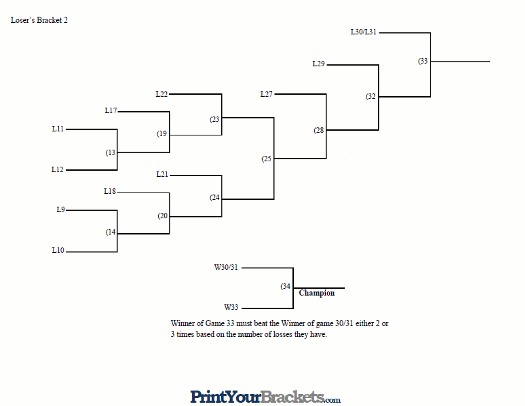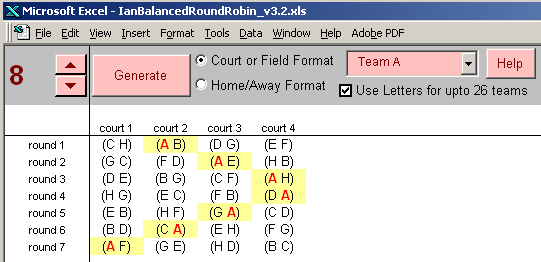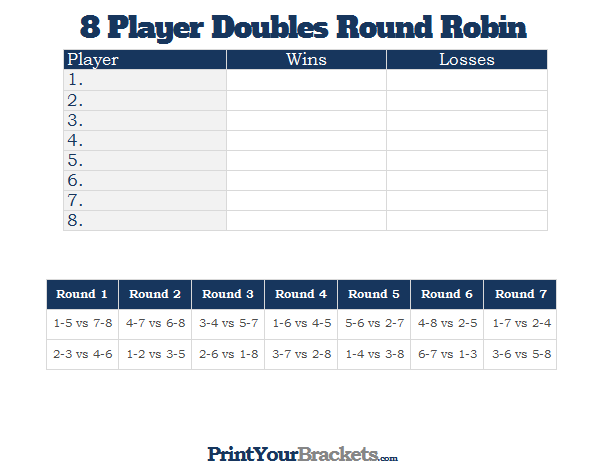
This simple format removes the need for seeding, guarantees that every team can play every other, and limits the number of byes per team to one, but limits the number of games played between the top teams tournaments are rarely willing to make this tradeoff.
#Round robin schedule creator full#
The aforementioned flaws with double round robins are more extreme in triple round robins.Ī full round robin eschews a prelim/playoff format in favor of one large round robin of every team. This is usually only found in regions with only a small number of established teams, with the most common scenario being 4 teams playing 9 games. In a triple round robin, every team plays every other thrice. This format is not particularly amenable to an odd number of teams because it forces multiple byes, so tournaments in this situation may split a team or field a house team. 6-team tournaments which want more games can have an advantaged final or break ties. Compare this to high school regular difficulty tournaments, which are short and easy enough to reasonably allow 11+ for most fields - note, however, that IS sets only have 12-13 packets and thus can only feasibly support 11 if a final is desired. This is common in college tournaments with six teams, as a tournament which is only able to draw that many teams is likely hard enough for 10 games to be a reasonable number. In a double round robin, every team plays every other twice. There are pre-made round-robin schedules available to spread the teams evenly across rooms as much as possible (which is impossible for four teams).Ĭertain uses of the round robin are very common for specific numbers of teams. However, for a round robin with an even number of teams, this can be undesirable because team 1 is kept in the same room all day. Once a complete schedule like the one above is obtained, the simplest way to assign matches to rooms is to have the first column represent one room, the second column a second room, and so on.

Teams playing the team 1 will then get a bye. The result of of this procedure is the following 9 game schedule:įor an odd number of teams, use the same procedure for one more than the number of teams, and choose one team (typically team 1) to treat as a bye. This continues until the final round, where team 1 plays against team 2. Repeating this procedure yields the following for rounds 2 through 4: Doing the same clockwise will have the same end result, so long as the choice is consistent throughout the entire process of constructing the schedule.


To determine the next round's pairings, leave team 1 fixed and rotate the other teams counter-clockwise, such that team 2 is where team 3 was the previous round, team 3 is where team 4 was, etc. Then, "snake" the teams in the schedule as follows:Įach pairing represents a game played in the first round. As with any sensible 10-team format, this will require 5 rooms. In this example, we will show a 10-team round robin.įirst, number the teams from 1 to 10. In its simplest form, a round robin can be constructed for any even number of teams as follows. This can be referred to as simply 8x2 ("eight by two") into 4x4 ("four by four"), with the final being implied. For example, consider a 16 team tournament which has two prelim brackets of 8 followed by rebracketing into four brackets of 4 for a total of 10 games + a final if needed. The use of round robins in brackets is standard practice and is often implied to be the format used - hence, tournament formats can frequently be described in terms of just their bracket sizes. Using a format involving round robins does not eliminate the need for seeding. Though round robins ensure that all the teams in a pool have a comparable schedule, it does not make any assurances about the relative strength between pools. This allows PPG to be used as a tiebreaker rather than PPB - head to head tiebreakers should be avoided if possible, as they double count the results of individual games, but this is not unique to round robins. Round robin play ensures that teams in the same round robin pool play against the same opponents, so there is less concern with strength of schedule.


 0 kommentar(er)
0 kommentar(er)
